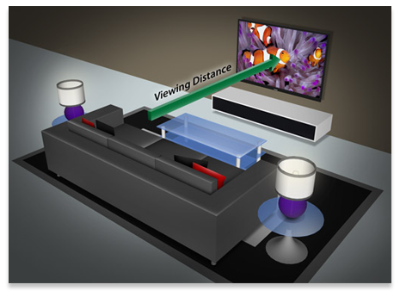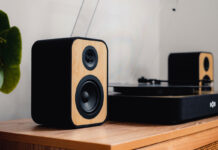
When it comes to getting a brand spanking new TV for the home, size is always one of top decision-making factors. Naturally, we all want the biggest, best TV money can buy. But you also need to be cognizant of what size will make the most sense for the room. And sometimes, that might mean scaling down your ambitions a bit; or conversely, looking at a TV bigger than what you intended.
There are a number of general recommendations on the proper viewing distance. One particular suggests that you divide the viewing distance by three to determine the smallest size TV (diagonal screen size, typically) for the room, and divide by 1.5 to get the largest. So if your TV is 5 feet (60 inches) away from the central viewing spot (say, the head of the bed), the largest TV you should get is 40”. If the distance is 10 feet (120 inches) away (say, in a living room setup), 40” is the smallest recommended TV size. And you shouldn’t go larger than 80”.
Not just about the bare bones numbers
 But in today’s world more than ever, there are other factors you need to take into consideration in order to determine the right size. What is the shape of the room, for instance, and what furniture do you already have in it? While the mathematical formula might suggest that a 60” TV is doable, for example, an awkwardly-shaped room with lots of furniture and other key focal points (like a big painting, for example) might make a 60” TV seem like too much. Will the TV be placed on a stand, or mounted on the wall? Does it sit flush, or is it on an articulating mount that allows you to angle it, and pull it forward for optimally viewing higher-definition content when desired?
But in today’s world more than ever, there are other factors you need to take into consideration in order to determine the right size. What is the shape of the room, for instance, and what furniture do you already have in it? While the mathematical formula might suggest that a 60” TV is doable, for example, an awkwardly-shaped room with lots of furniture and other key focal points (like a big painting, for example) might make a 60” TV seem like too much. Will the TV be placed on a stand, or mounted on the wall? Does it sit flush, or is it on an articulating mount that allows you to angle it, and pull it forward for optimally viewing higher-definition content when desired?
If you have buddies over to watch the game, or family movie night, how many people will be viewing off-axis versus sitting in the sweet spot? And thus will the TV be big enough for everyone to get a good view? What kind of content will you be watching? A 60” or 80” TV might be a bit much for the occasional kid’s cartoon and primetime sitcom. But if you watch lots of movies, play video games, or often sit down for lengthy binge-viewing sessions of high-quality programs like Breaking Bad and House of Cards, you’ll want that big screen experience.
Perhaps the most critical question to ask, however, relates to the resolution: is the TV 720p, 1,080p, or 4K? And, just as important, what resolution will the main source content be?
Resolution is key
 The bottom line is that the more resolution you have, the closer you can sit to the TV.
The bottom line is that the more resolution you have, the closer you can sit to the TV.
One of the biggest issues with sitting too close to a TV (aside from eye strain and fatique, of course) is pixelation: if the image isn’t incredibly sharp, it’ll appear blurred and ruin the experience. To get an ides of what this would look like, take a basic low-resolution photo you’ve snapped with your smartphone, then zoom in on the computer. See those blurred dots, which come far more into focus the closer you look? That’s pixelation.
But if you’re watching, say, a 4K movie, sitting closer up than the recommended viewing charts suggest may be perfectly feasible. Because the resolution and pixel count is so high, pixelation won’t be an issue.
On the other hand, with higher resolution TVs and content, sitting too far away robs you of the details that you have paid to enjoy. Why buy a 1,080p TV, then sit too far away from it to actually see every nuance of colour, the sharpness of detail, and every pore on the characters’ faces? Being too far away can also make certain scenes difficult to see, in general.
Content
What’s perhaps even more important is not the resolution capabilities of the TV, but the resolution of the content you’ll be watching. If you’re getting a 4K TV, for example, but will be watching 90% 1080p or 720p content, with the occasional 4K movie thrown in, you’re better off calculating your purchase choice based on recommendations set out for 1,080p resolution. It’s easy enough, after all, to shift a couch or chair closer to the TV anyway. And this will also make for a comfortable experience when you have to resort to (yuck!) standard-def content every now and then.
If you’re buying a 4K TV and plan to watch lots of 4K content (as it becomes available), you may very well be able to get away with a size larger than 40” if you’re sitting just 5 feet away.
What to do?
 In my opinion, it’s always best to opt for the largest possible size for the viewing distance, taking into consideration all of the other noted factors as well. TVs can be the focal point of the room, and you want them to make a powerful statement when they are. You also want to be able to maximize the viewing experience, especially if you’re an avid TV viewer (like me!)
In my opinion, it’s always best to opt for the largest possible size for the viewing distance, taking into consideration all of the other noted factors as well. TVs can be the focal point of the room, and you want them to make a powerful statement when they are. You also want to be able to maximize the viewing experience, especially if you’re an avid TV viewer (like me!)
If you are buying a 4K TV, you might still want to choose the size based on the knowledge that you’ll be watching predominantly 1,080p content for now. While the situation looks promising for 4K content this year, with services like Netflix and YouTube confirming plans, the reality is that most of us will we watching 1,080p TV for some time to come.
When all else fails, use common sense. While the latest 80” TV might seem like the coolest thing ever, it may not be the smartest choice for your 800 square-foot condo. And likewise, while the 40” 1,080p TV might fit better into your budget, if the TV will be placed 10 feet or more away from the couch in your suburban home’s den, it would be wise to wait and invest a few more bucks in a larger screen. That way, you’ll get far more bang for those hard-earned bucks.



